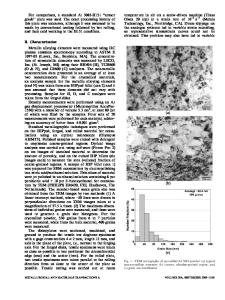Forging, textures, and deformation systems in a B2 FeAl alloy
- PDF / 719,944 Bytes
- 14 Pages / 612 x 792 pts (letter) Page_size
- 49 Downloads / 358 Views
MATERIALS RESEARCH
Welcome
Comments
Help
Forging, textures, and deformation systems in a B2 FeAl alloy P. Zhao, D. G. Morris, and M. A. Morris-Mu¯noz Institute of Structural Metallurgy, University of Neuchˆatel, Avenue de Bellevaux 51, 2000 Neuchˆatel, Switzerland; and CENIM, Avenida Gregorio del Amo 8, 28040 Madrid, Spain (Received 23 October 1997; accepted 20 August 1998)
High-temperature forging experiments have been carried out by axial compression testing on a Fe–41Al–2Cr alloy in order to determine the deformation systems operating under such high-speed, high-temperature conditions, and to examine the textures produced by such deformation and during subsequent annealing to recrystallize. Deformation is deduced to take place by the operation of k111l h110j and k111l h112j slip systems at low temperatures and by k100l h001j and k100l h011j slip systems at high temperatures, with the formation of the expected strong k111l textures. The examination of the weak k100l texture component is critical to distinguishing the operating slip system. Both texture and dislocation analyses are consistent with the operation of these deformation systems. Recrystallization takes place extremely quickly at high temperatures (above 800 ±C), that is within seconds after deformation and also dynamically during deformation itself. Recrystallization changes the texture such that k100l textures superimpose on the deformation texture. The flow stress peak observed during forging is found at a very high temperature. Possible origins of the peak are examined in terms of the operating slip systems.
I. INTRODUCTION
The deformation of iron aluminide alloys at high temperatures is characterized by a peak in flow stress at intermediate temperatures.1 – 4 While early studies on FeAl alloys did not show such a peak,5 subsequent studies make it clear that the peak exists for all alloy compositions, extending from Fe3 Al stoichiometry up to near FeAl stoichiometry, and that it is important to avoid the confusing strengthening effects of vacancy hardening in analyses.6,7 A considerable amount of work has examined the nature of the peak in both families of alloys and suggested reasons for its origin.8 – 10 For FeAl based alloys it seemed for some time reasonably clear that deformation by glide of k111l superdislocations at low temperatures was superseded by deformation by glide of k100l dislocations at temperatures above the peak.4 – 6 The reasons for the change of Burgers vector seem to be tied to the locking of k111l superdislocations by mechanisms such as dislocation decomposition (to k110l and k100l dislocations),11 climb locking,9,12 or vacancy hardening.7 It may also be noted that some of the hardening models, for example vacancy hardening, do not require, a priori, any change of Burgers vector, and the stress peak could be produced by the existence of a temperature range where k111l dislocations are pinned followed by a range where they are released.7 Some questions have been raised about the validity of these results by recent experim
Data Loading...










